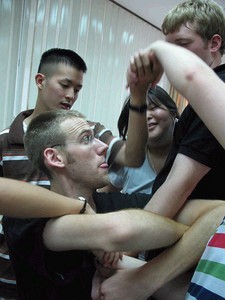 Summary: A good icebreaker or teambuilding activity for new people to learn to work together – in close physical proximity! The goal is to figure out how to untangle the human knot without letting go of hands.
Summary: A good icebreaker or teambuilding activity for new people to learn to work together – in close physical proximity! The goal is to figure out how to untangle the human knot without letting go of hands.
Ages: 12 and up. Recommended number of people: 7-200 (group sizes of 10 are ideal). Messiness factor: Might break a sweat – (close proximity – hope you’re not claustrophobic!). Materials required: None. Recommended setting: Both indoors or outdoors.
Human Knot Game
Goals of the Human Knot Game:
- Team building and communication
- Problem solving
- Ice-breaker or get to know others better
Setup for the Human Knot Game:
This game is versatile in that multiple group sizes can play. Form groups of about 10 people each. Have each group standing, facing towards each other, in a circle. Each person should be standing shoulder to shoulder. First, instruct everyone to lift their left hand and reach across to take the hand of someone standing across the circle. Next, have everyone lift their right and reach across to take the hand of another person standing across the circle. Make sure that no one is holding hands with someone standing directly beside the person.

How to Play the Human Knot Game
To play, the groups must communicate and figure out how to untangle the knot (forming a circle of people) without ever letting go of any hands. If you wish, this icebreaker can be played competitively, in which the facilitator says “Ready.. Set.. Go!” and has all the groups race to become the first group to finish. If any group member lets go of a hand (breaks the chain), then the group must start from the beginning, or you could impose a penalty/punishment for that person (e.g. wear a blindfold).
This game typically takes 15-30 minutes to complete. You can impose a time limit if you wish to make the game more challenging. When you are done with the Human Knot activity, you can ask some debrief questions if you wish, such as “How well did you group work together? What strategies did your group adopt? How did it feel to solve the game?” etc.
Variations
To increase the difficulty level, you can either (1) blindfold some of the players or (2) require that the game be played silently (no talking).